This building first opened its doors in 1809 as the Borough National School. The interior of this well-known building has been much altered, but the exterior has changed little since it was designed by the noted Irish architect Francis Johnston. The school was free of charge to children of all denominations. It became known as the ‘Old Borough’, when the New Borough School was opened. The building was converted into a public house in 2000.
A photograph and text about The Old Borough.
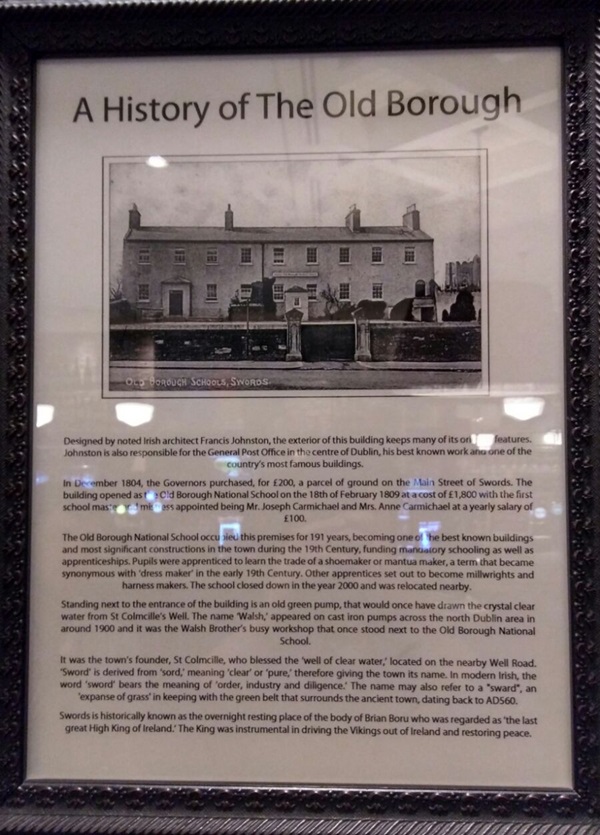
The text reads: Designed by noted Irish architect Francis Johnston, the exterior of this building keeps many of its original features. Johnston is also responsible for the General Post Office in the centre of Dublin, his best known work and one of the country’s most famous buildings.
In December 1804, the Governors purchased, for £200, a parcel of ground on the Main Street of Swords. The building opened as the Old Borough National School on the 18 of February 1809 at a cost of £1,800 with the first school master and mistress appointed being Mr Joseph Carmichael and Mrs Anne Carmichael at a yearly salary of £100.
The Old Borough National School occupied these premises for 191 years, becoming one of the best known buildings and most significant constructions in the town during the 19th century, funding mandatory schooling as well as apprenticeships. Pupils were apprenticed to learn the trade of a shoemaker or mantua maker, a term that became synonymous with dress maker in the early 19th century. Other apprentices set out to become millwrights and harness makers. The school closed down in the year 2000 and was relocated nearby.
Standing next to the entrance of the building is an old green pump, that would once have drawn the crystal clear water from St Colmcille’s Well. The name Walsh, appeared on cast iron pumps across the north Dublin area in around 1900 and it was the Walsh Brother’s busy workshop that once stood next to the Old Borough National School.
It was the town’s founder, St Colmcille, who blessed the ‘well of clear water’, located on the nearby Well Road. Sword is derived from ‘sord’, meaning clear or pure, therefore giving the town its name. In modern Irish, the word sword bears the meaning of order, industry and diligence. The name may also refer to a ‘sward’, an ‘expanse of grass’ in keeping with the green belt that surrounds the ancient town, dating back to AD560.
Swords is historically known as the overnight resting place of the body of Brian Boru who was regarded as the last great High King of Ireland. The King was instrumental in driving the Vikings out of Ireland and restoring peace.
A photograph of historical Dublin being recreated.
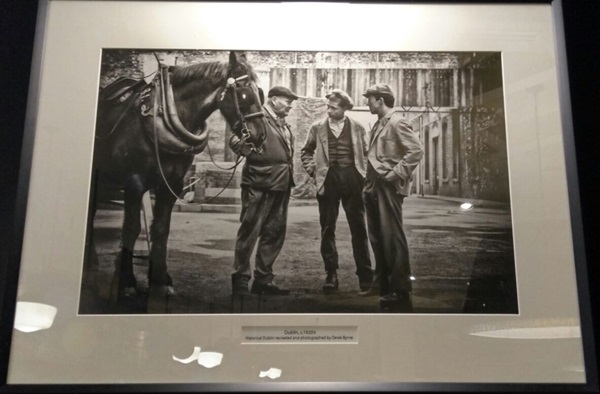
A collection of old photographs of Swords.
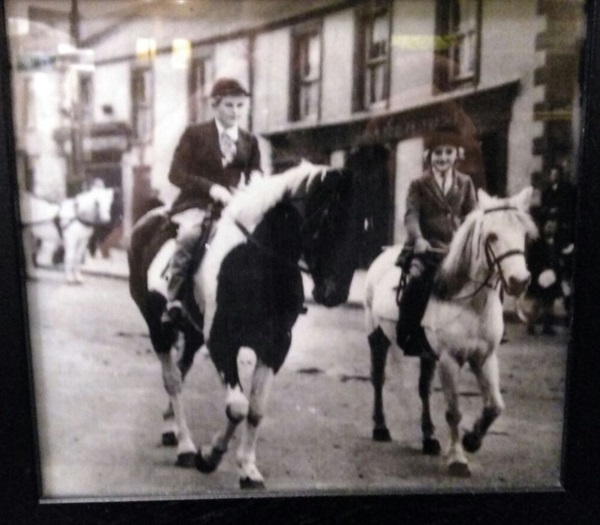
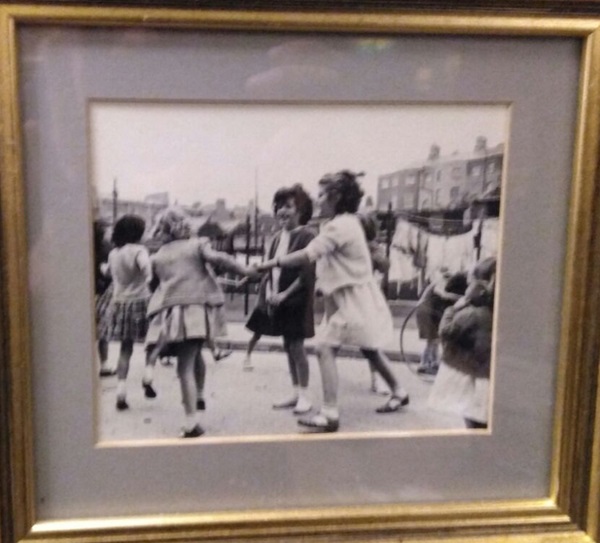
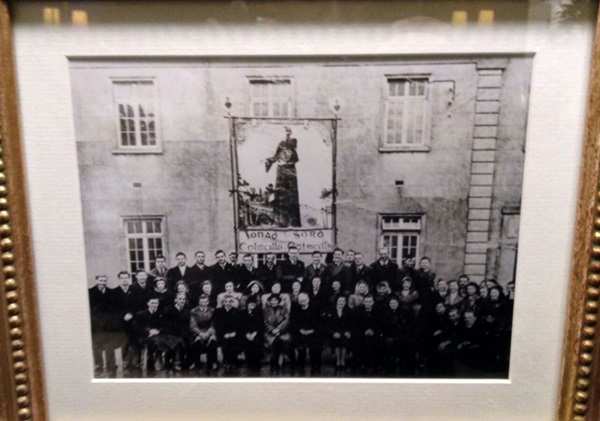
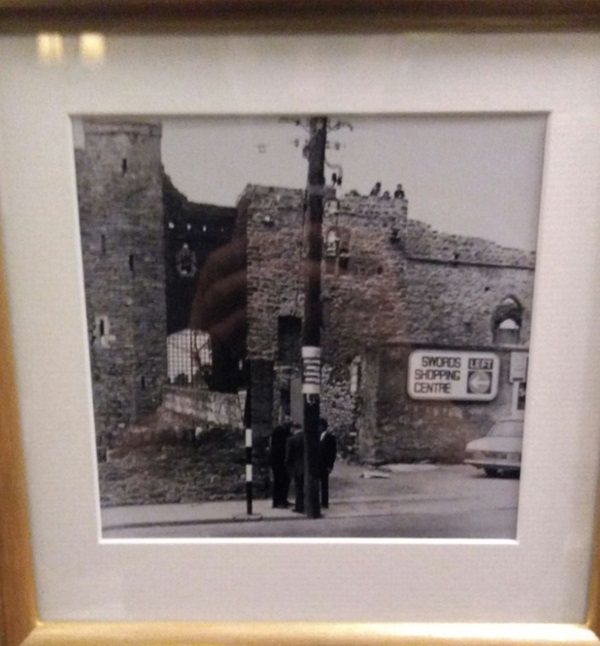
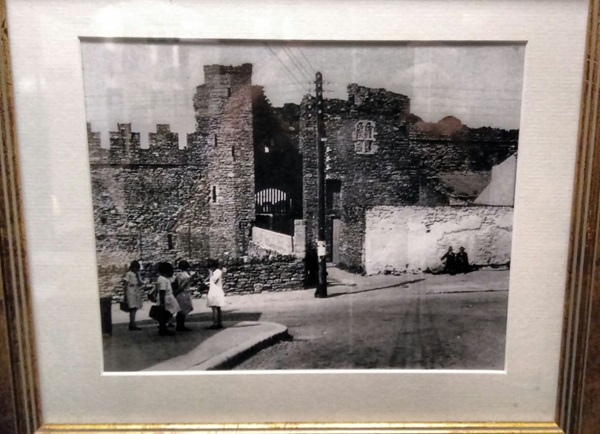
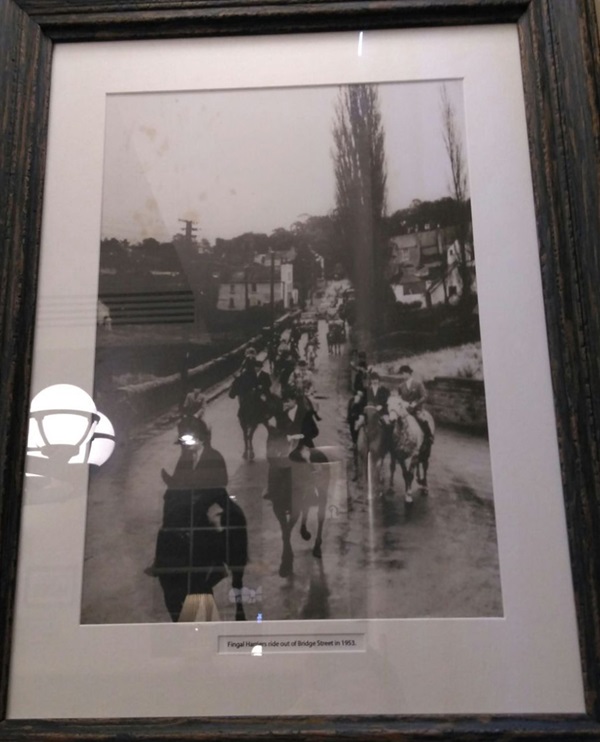
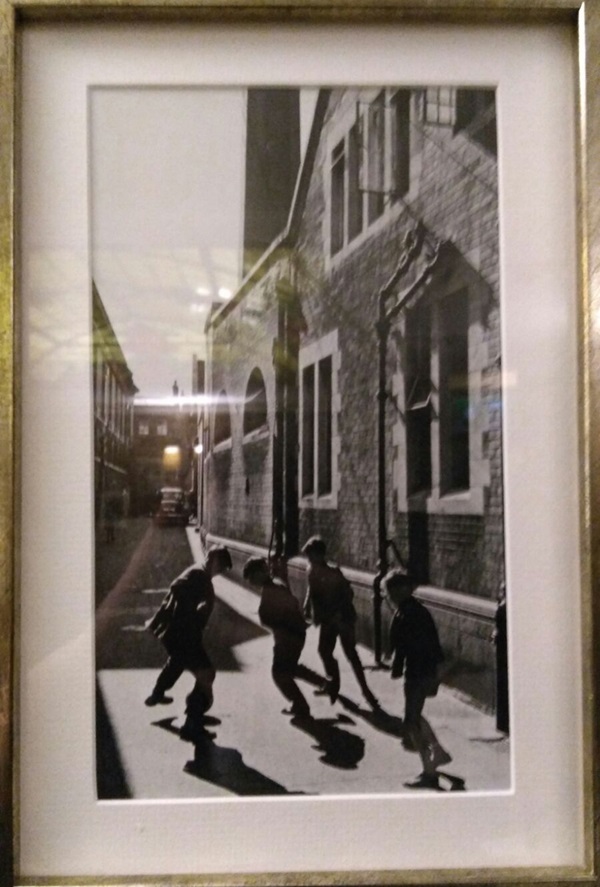
With special thanks to Bernadette Marks at the Swords Historical Society and the residents of Swords for use of this collection of photos and others that can be seen displayed at the Old Borough.
Since the Society was founded in March 1982, they have succeeded in recording, preserving and promoting all aspects of the history of the greater Swords area and are always interested in hearing from those with a tale to tell or old photos to loan or donate.
A painting entitled Crowds, O’Connell Bridge, Dublin, by Ross Eccles.
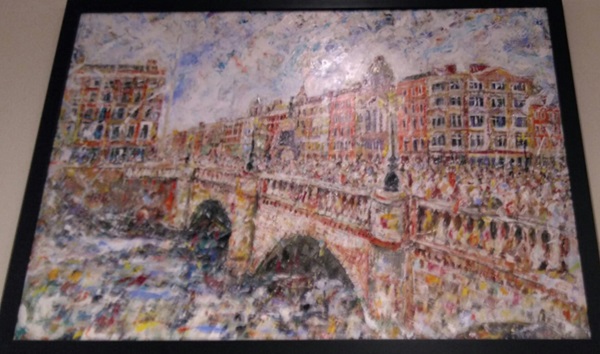
The text reads: Ross Eccles was raised in the scenic Ribble Valley in Lancashire, England and was educated at the Birmingham School of Art, qualifying as an architect.
Ross finally settled in the Greater Dublin area in 1971 after extensive travelling fuelled his passion for art.
This painting expresses Ross’s passion for using raw colour, applied with brush and palette knife in layers and in a manner that is identifiably his own. The sense of building structure and the turmoil of movement of anonymous crowds is typically achieved with little, if any figurative detail. Nonetheless his architect’s eye for perspective ensures the viewer clearly identifies and has affinity with the subject matter.
A painting entitled Evening view of Samuel Beckett Bridge, by Aidan Flanagan.
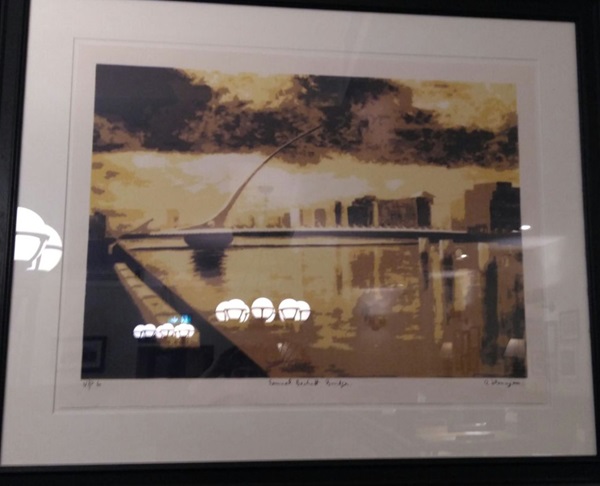
The text reads: Aidan Flanagan is an artist/printmaker originally from Portlaoise Co. Laois and now based in Ratoath, Co Meath. Aidan has painted landscapes since 1980s and learned how to screenprint in the late 1990s. He subsequently learned further intaglio techniques and has been printmaking on a fulltime basis since 2008. His work has been exhibited at Royal Hibernian Academy, Royal Ulster Academy, International Print Centre New York and various other galleries in the USA and Europe.
This print was commissioned by J D Wetherspoon in 2015 and is an enlargement of an eight layer screenprint depicting the new Samuel Beckett Bridge on the River Liffey in the Centre of Dublin. The view depicts an evening scene of the bridge and river, looking westwards from Sir John Rogersons Quay. The Bridge, designed by architect Santiago Calatrava is a cable stayed bridge, which was named after the world famous Irish writer Samuel Beckett and was opened in 2009.
A timber sculpture on display in the pub.
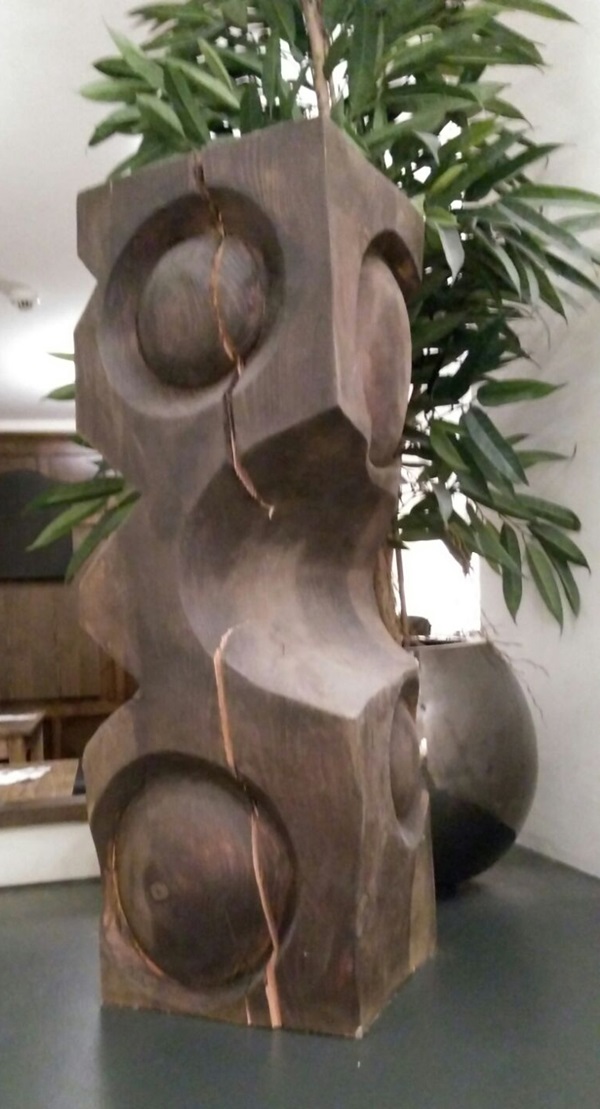
The text reads: The timber plinth was created by rough carving the oak with a chainsaw, following initial sketches. During production of his work, Martin sketches on the sculpture with the tip of the chainsaw, using power sanders and chisels to do the finer work.
“The whole ethos behind my carvings in the Maon Koru which represents life, regeneration and new beginnings I like to think I give the diseased or windblown tree a new like as a sculpture which hopefully will stand for another 200 years. From the start of my tree surgery career I have always collected interesting pieces of wood, hollow stems, burrs, roots, which in my mind are sculptures in themselves.”
Martin takes his inspiration from natural forms and anything that has been shaped by the element giving unique grains and shapes to raw materials.
External photograph of the building – main entrance.
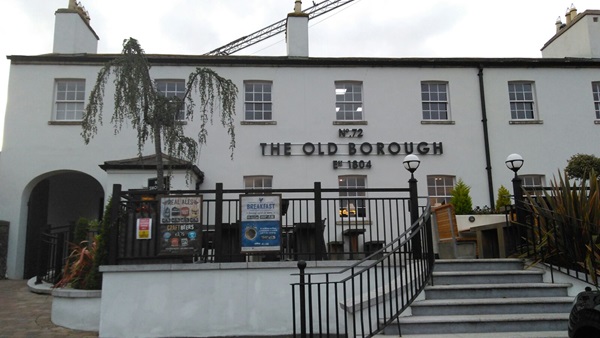
If you have information on the history of this pub, then we’d like you to share it with us. Please e-mail all information to: pubhistories@jdwetherspoon.co.uk